LCD Color Accuracy
So far the LCD hasn't been very impressive, but let's take a look at how it performs in regards to color accuracy. Not everyone wants a glaringly bright display, after all. As mentioned, we will be looking at the uncalibrated performance as well is calibrated performance using both Monaco Optix XR Pro and ColorEyes Display Pro.
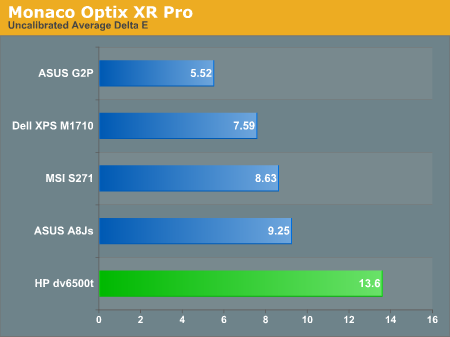
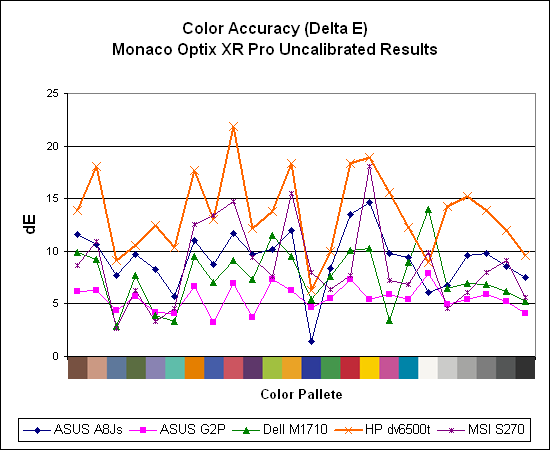
Without calibration, this is the worst LCD we've encountered so far. Only four out of 24 of the measured color values have a Delta E of less than 10 -- and remember that ideally Delta E should be less than one! Remember that when you're viewing movies, the display overlay mode will bypass any color profiles you may have selected, so basically you're going to get very poor color quality with this notebook. But what happens after calibration?
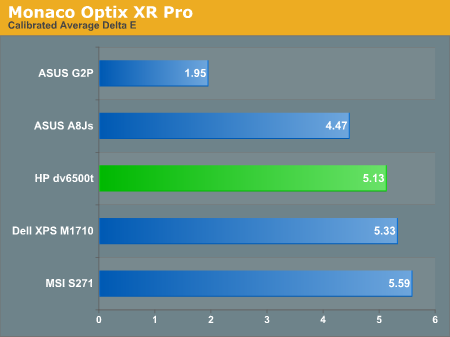
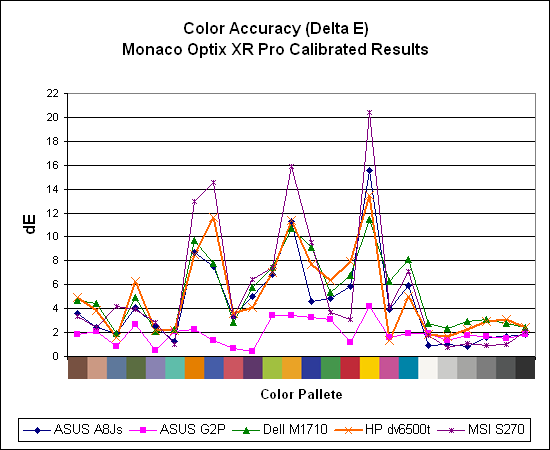
Using Monaco Optix XR, accuracy improves quite a lot and the LCD panel now basically matches the overall performance of the Dell XPS M1710 and the MSI S271. It's still not great, but it's not terrible either. We're not done yet, however, because we wanted to see if ColorEyes Display Pro managed to calibrate the colors any better.
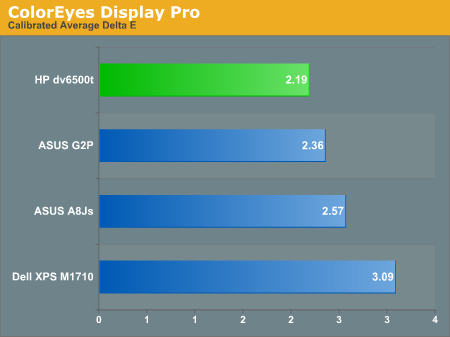

Where Monaco Optix XR Pro has a tendency to have inaccuracy spikes on yellow/orange colors, ColorEyes Display Pro has a pretty major spike on something close to teal. Overall, though, the average Delta E is much lower using ColorEyes Display Pro on all of the laptops... except one. It turns out that the best laptop LCD we've used so far -- the ASUS G2P -- gets better results when calibrated using Monaco Optix XR Pro. Also worth mentioning is that the MSI S271 appears to have some compatibility problems with ColorEyes Display Pro, as the software would hang whenever we tried to begin profiling. Even the dv6500t manages to top the ColorEyes Delta E chart, we would still much rather use the ASUS G2P (or any other laptop with a similarly bright display).
We should also note that the default Delta E reported by ColorEyes appears to be extremely good, but the selection of test colors is extremely limited. We validated color accuracy using a Gretag Macbeth chart, which is what Monaco Optix XR Pro uses. The default validation for color eyes uses 15 color swatches instead of 24, and actually the 15 swatches consist of 12 shades of gray and three colors. While that may be fine for people that work in black and white, actual color accuracy means more to us, even if the display can no longer score a "perfect" Delta E of less than 1.0.
One final comment on the displays before we move on: since HP is a large OEM, it is very likely that they source their LCD panels from more than one manufacturer. While the dv6500t that we tested has a relatively poor display, it's entirely possible that other HP laptops within the same family might have a better display. The same goes for other laptop manufacturers, of course, but for better or for worse we are only able to evaluate the LCDs on the laptops we receive. Then again, we would rather get a sample LCD that may be worse than average and evaluate it as such than to get a great LCD and praise it, only to find out that most LCDs in the same family perform much worse.
So far the LCD hasn't been very impressive, but let's take a look at how it performs in regards to color accuracy. Not everyone wants a glaringly bright display, after all. As mentioned, we will be looking at the uncalibrated performance as well is calibrated performance using both Monaco Optix XR Pro and ColorEyes Display Pro.


Without calibration, this is the worst LCD we've encountered so far. Only four out of 24 of the measured color values have a Delta E of less than 10 -- and remember that ideally Delta E should be less than one! Remember that when you're viewing movies, the display overlay mode will bypass any color profiles you may have selected, so basically you're going to get very poor color quality with this notebook. But what happens after calibration?


Using Monaco Optix XR, accuracy improves quite a lot and the LCD panel now basically matches the overall performance of the Dell XPS M1710 and the MSI S271. It's still not great, but it's not terrible either. We're not done yet, however, because we wanted to see if ColorEyes Display Pro managed to calibrate the colors any better.


Where Monaco Optix XR Pro has a tendency to have inaccuracy spikes on yellow/orange colors, ColorEyes Display Pro has a pretty major spike on something close to teal. Overall, though, the average Delta E is much lower using ColorEyes Display Pro on all of the laptops... except one. It turns out that the best laptop LCD we've used so far -- the ASUS G2P -- gets better results when calibrated using Monaco Optix XR Pro. Also worth mentioning is that the MSI S271 appears to have some compatibility problems with ColorEyes Display Pro, as the software would hang whenever we tried to begin profiling. Even the dv6500t manages to top the ColorEyes Delta E chart, we would still much rather use the ASUS G2P (or any other laptop with a similarly bright display).
We should also note that the default Delta E reported by ColorEyes appears to be extremely good, but the selection of test colors is extremely limited. We validated color accuracy using a Gretag Macbeth chart, which is what Monaco Optix XR Pro uses. The default validation for color eyes uses 15 color swatches instead of 24, and actually the 15 swatches consist of 12 shades of gray and three colors. While that may be fine for people that work in black and white, actual color accuracy means more to us, even if the display can no longer score a "perfect" Delta E of less than 1.0.
One final comment on the displays before we move on: since HP is a large OEM, it is very likely that they source their LCD panels from more than one manufacturer. While the dv6500t that we tested has a relatively poor display, it's entirely possible that other HP laptops within the same family might have a better display. The same goes for other laptop manufacturers, of course, but for better or for worse we are only able to evaluate the LCDs on the laptops we receive. Then again, we would rather get a sample LCD that may be worse than average and evaluate it as such than to get a great LCD and praise it, only to find out that most LCDs in the same family perform much worse.










26 Comments
View All Comments
Procurion - Sunday, June 24, 2007 - link
Having bought a Sager after a LOT of research(and an RMA'd Ferrari-Acer, lol, not the car) I question the quest for extreme resolution. My laptop has a native 1900x1200 screen which I consider unuseable on a 17" screen....1024x768 puts a LOT of info on screens and I wonder why the preoccupation with "ultra resolution"? If this is a casual use/business use type of laptop, those high rez settings aren't necessary at all. Either that or my 40-something bespectacled eyes just ain't cuttin' it anymore...:)strikeback03 - Monday, June 25, 2007 - link
Personally, I consider 1024x768 the bare minimum - I can't fit as much on the screen as I like. My Thinkpad has a 1400x1050 15" screen that I consider about perfect. As mentioned, the good thing is that both 1024x768 and 1600x1200 are available in the same screen size.On a side note, Lenovo still has T60s with Flexview IPS screens - we just bought one for work. They might not want to send one out for review though as word has it that the T61 will not be available with Flexview and will be hard to get with a 4:3 ration screen at all.
JarredWalton - Sunday, June 24, 2007 - link
I don't have a huge problem with the resolution - it's *okay* - but it would be nice to have options. Regardless, the quality of the display is not at all good compared to a lot of other recent laptops. Ideally, users should be able to choose from more than one screen config, but that's often limited to more expensive notebook models. Running Windows Vista, I feel 1280x800 is cramped, 1440x900 is passable, and 1680x1050 given enough room to make me happy. Then again, I run a 30" desktop LCD at 2560x1600.... :)Procurion - Monday, June 25, 2007 - link
Point taken about the need for some options rather than "one size fits all"-as a matter of fact my post was inspired because my needs/resolutions are different than, say, yours. As you and several other authors here have pointed out in the past, for the costs involved it is beyond me why the manufacturers put some really awful screens out there on their laptops....After opening a laptop up and booting it, what is the first thing that makes an impression? And you have to look at it every time you use the damn thing? LOL...legoman666 - Saturday, June 23, 2007 - link
You know... you could get rid of all the problems with your benchmarking programs not working on Vista by simply uninstalling it and installing Windows XP instead. My sister (not a big computer person) just bought a new laptop. The FIRST thing she and I did when it arrived was uninstall Vista and put XP on it.JarredWalton - Saturday, June 23, 2007 - link
Which requires finding drivers for the chipset and slipstreaming them onto an XP CD. There's no floppy drive with this laptop. Anyway, like it or not, 95% of new PCs are going to be coming with Vista installed most likely, and I would say the number of people that plan on wiping the drive and installing XP instead is going to be very limited.legoman666 - Sunday, June 24, 2007 - link
What do you mean you'd have to slipstream the chipset drivers into the windows installation? I've isntalled windows countless times on many different machines and I have never had to do such a thing. I just isntall windows normally, then once it's installed, I install all the drivers. It really isn't difficult... Nor would you need a floppy drive unless you plan on installing windows onto a RAID array. I don't mean to sound rude or anything, but neither of those arguments are really valid. Although, the bit about people not uninstalling Vista in favor of XP is probably true...JarredWalton - Sunday, June 24, 2007 - link
I booted up off of the XP CD (see, I really did try to install XP), but because the hard drive is SATA XP apparently wasn't able to see it. I got the dreaded "No hard drives detected" error message, and that was pretty much it for my XP attempt.See, the BIOS lacks any options to set/change the SATA mode and so it appears to be running as an AHCI SATA drive. That setting generally requires drivers on a floppy in order to work (in my experience). HP isn't selling the laptop with XP, and they don't intend to support such a configuration. That being the case, why spend time trying to work around a limitation in order to test something most people aren't planning on using?
If you want a laptop with XP, you'd be far better off purchasing a laptop that comes that way. There are still plenty of those available.
NoGodForMe - Tuesday, June 26, 2007 - link
Jarred is correct about slip streaming the drivers to boot XP. I have created a guide with step by step instructions to installing XP on the DV6500T. I can run XP or Vista. This laptop is a good all around performer. Not the fastest, but does everything needed and is really great with XP on it. I installed Tribes2 and UT2K4 and I've got the integrated X3100, plays both of them great.Here's my guide. This would be a good idea for the Macbook Pro, or the Asus G1S.
http://www.nogodforme.com/HPDV6500T.htm">http://www.nogodforme.com/HPDV6500T.htm
The key to my guide is that it's step by step with links to all drivers. Would be nice if someone did this for VMWare player, parallels, and bootcamp.
Vidmar - Tuesday, June 26, 2007 - link
Jarred,I just purchased a number of Gateway 155C convertibles (tablet pc) for my office. As you said XP won't install because of the lack of an appropriate SATA driver. But it's so easy to slipstream these SATA drivers into your XP build using nLite. I had a working XP install CD in less than 10 mins!
In any case as other have said a look at lower weight laptops and tablet PCs would be nice to see. Take a close look at the Gateway 155C; it's a very good design.